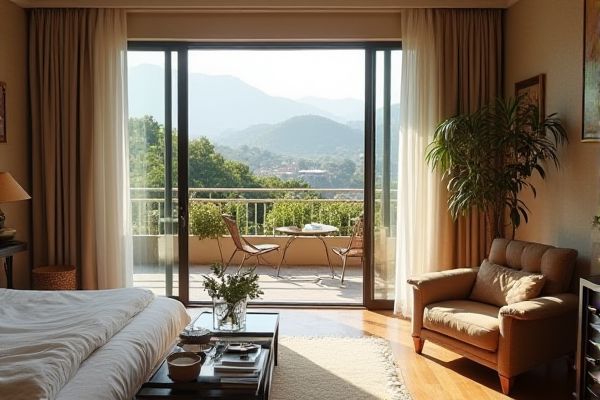
Balconies are small, elevated platforms attached to the exterior of a building, offering limited space and often providing a cozy outdoor retreat for your apartment or condo. Terraces are larger, flat open areas that can be situated on rooftops or ground levels, ideal for hosting gatherings and enjoying expansive views; explore the full article to understand which outdoor space best suits your lifestyle and needs.
Table of Comparison
| Feature | Balcony | Terrace |
|---|---|---|
| Definition | Elevated platform projecting from a building, enclosed by a railing or wall. | Flat, open outdoor space on the rooftop or upper floor of a building. |
| Size | Typically small, suited for 1-2 people. | Larger, can accommodate gatherings and furniture. |
| Location | Attached to individual rooms or apartments. | Located on rooftops or top floors, accessible to multiple rooms. |
| Structure | Cantilevered or supported platform extending outward. | Flat surface, part of the building's roof structure. |
| Common Uses | Relaxation, small garden, fresh air. | Entertainment, gardening, social gatherings. |
| Access | Direct access from a single room. | Often accessible from multiple rooms or communal area. |
Understanding the Difference: Balcony vs Terrace
A balcony is a small platform projecting from the wall of a building, typically on an upper floor and enclosed by a railing or balustrade, providing outdoor space for individual apartments. In contrast, a terrace is a larger, open, flat area, often located on the ground level or rooftop, designed for communal use or extended outdoor living. Understanding these distinctions helps in architectural planning and property valuation, as terraces offer more expansive space compared to the limited area of balconies.
Definition and Key Features
A balcony is a small, elevated platform projecting from the wall of a building, typically enclosed by a railing and accessible from an upper-floor room. A terrace is a larger, flat outdoor area often located on the ground level or roof, providing more space for seating and activities. Both structures enhance outdoor living but differ in size, location, and functionality.
Placement and Structure
A balcony is a platform projecting from the wall of a building, typically on upper floors, supported by brackets or columns and enclosed by a railing, offering limited space. A terrace is a flat, open area usually located on the ground or rooftop, larger in size, and often integrated into the building's architecture without projection. Balconies serve as small outdoor extensions of individual rooms, whereas terraces function as communal or private outdoor living spaces.
Size and Design Variations
Balconies are typically smaller, cantilevered structures attached to a building's facade, designed to maximize space in urban settings, often featuring railings or glass enclosures for safety. Terraces tend to be larger, open, flat areas either on rooftops or integrated into the building's footprint, allowing for more extensive landscaping, seating, and multifunctional uses. Your choice between a balcony and a terrace should consider the available space, structural support, and intended outdoor activities to optimize design and functionality.
Purpose and Functionality
Balconies provide your home with compact outdoor spaces primarily designed for relaxation, enjoying fresh air, or placing small plants. Terraces serve a broader purpose, often accommodating larger gatherings, outdoor dining, or gardening due to their expansive surface area. Both enhance living spaces, but terraces offer greater versatility and functionality compared to balconies.
Privacy and Accessibility
Balconies offer limited privacy due to their open, protruding design and closer proximity to neighbors, often enclosed by railings or glass panels that provide minimal screening. Terraces provide enhanced privacy, typically being larger, more secluded outdoor spaces often surrounded by walls, greenery, or partitions that shield from external views. Accessibility-wise, balconies are usually attached to individual apartment units with direct access from interior rooms, while terraces may serve multiple units or entire floors, accessible via shared corridors or staircases.
Construction Materials Used
Balconies are typically constructed using reinforced concrete, steel, or wood framed with materials like glass, metal railings, or tempered safety glass to ensure durability and safety. Terraces often involve more extensive groundwork, incorporating materials such as stone, pavers, or tiles over waterproof membranes to withstand weather exposure and support heavier loads. Your choice between a balcony or terrace should consider these material differences for structural integrity and aesthetic preferences.
Space Utilization and Landscaping Options
Balconies, typically smaller and attached to a single room, offer limited space utilization but allow for compact landscaping options like potted plants and vertical gardens. Terraces provide expansive outdoor areas suitable for diverse landscaping features such as lawns, shrubs, and seating arrangements, enhancing outdoor living experiences. Your choice depends on available space and the scope of greenery or relaxation zones you wish to create.
Pros and Cons of Balconies
Balconies offer outdoor space without requiring extra land, providing a private area for relaxation and fresh air while enhancing your property's aesthetic and market value. However, balconies typically have limited space, which can restrict furniture placement and activities, and they may require regular maintenance due to exposure to weather elements. For your living needs, balconies are ideal in urban settings where space is constrained, but may not offer the expansive outdoor experience that terraces provide.
Pros and Cons of Terraces
Terraces provide spacious outdoor living areas that enhance property value and offer panoramic views, making them ideal for relaxation and social gatherings. Their open design promotes better air circulation and sunlight exposure but requires regular maintenance to protect against weather damage. Terrace construction often involves higher costs and structural considerations compared to balconies, impacting overall budget and design flexibility.
 homyna.com
homyna.com